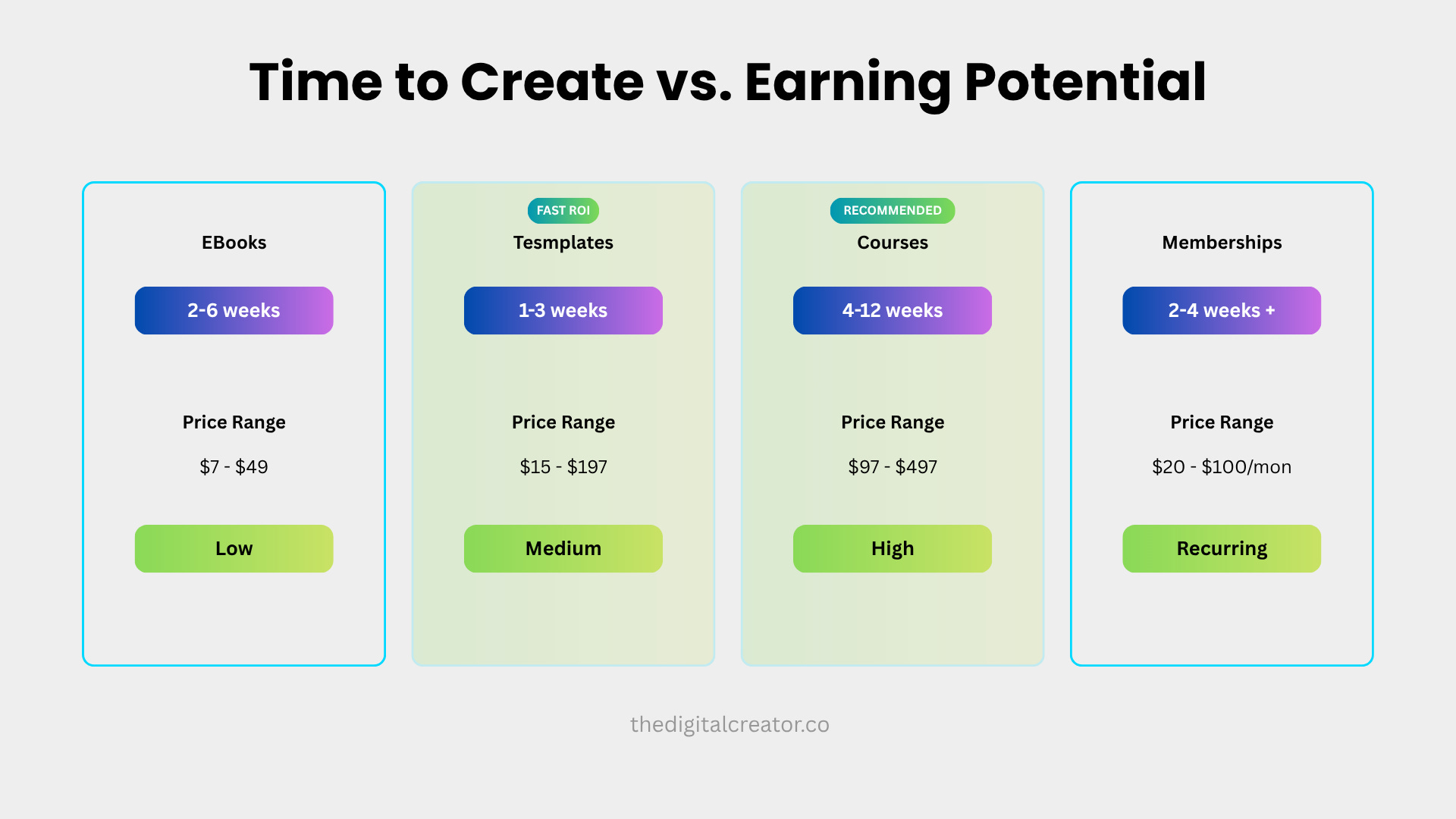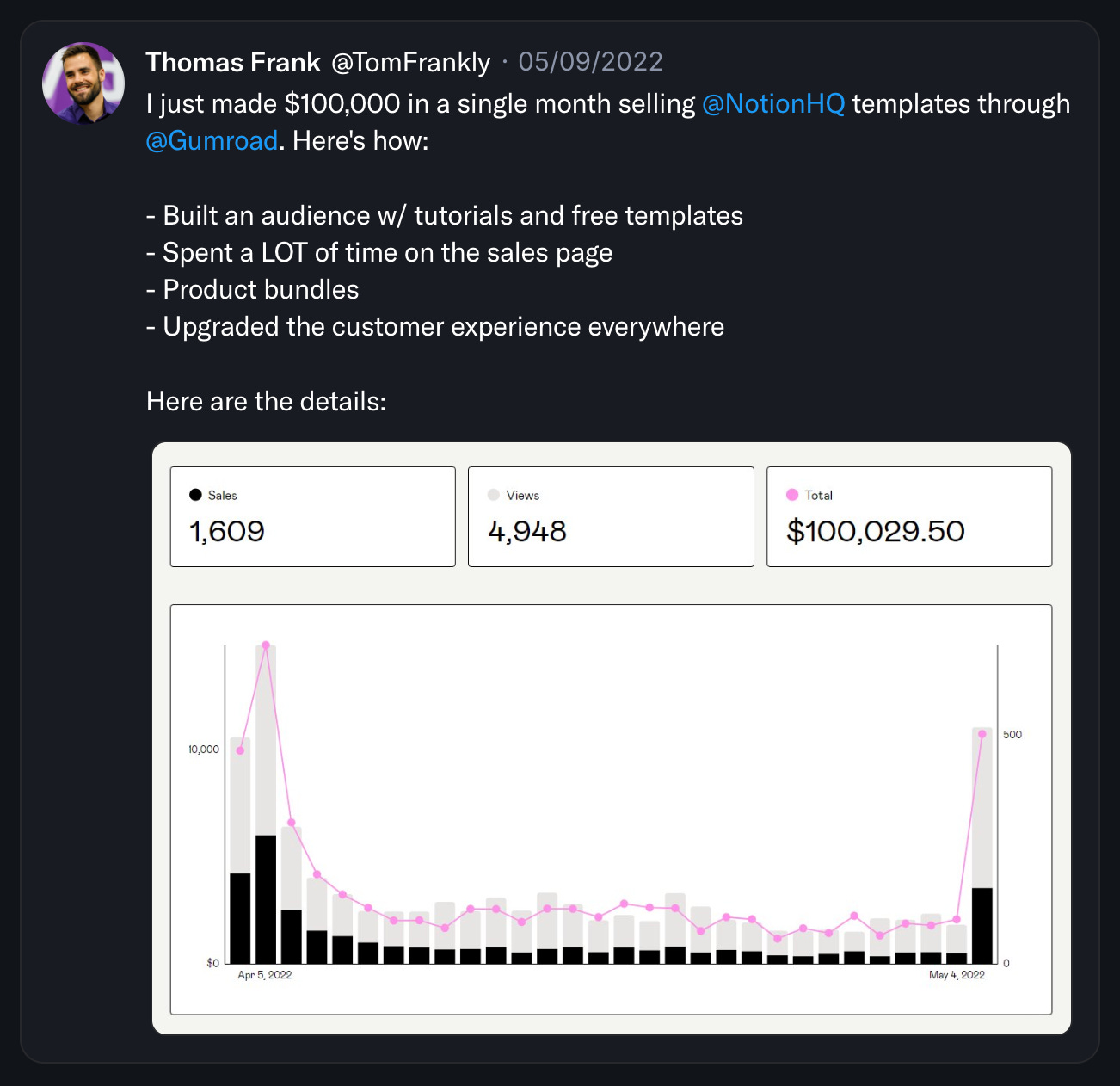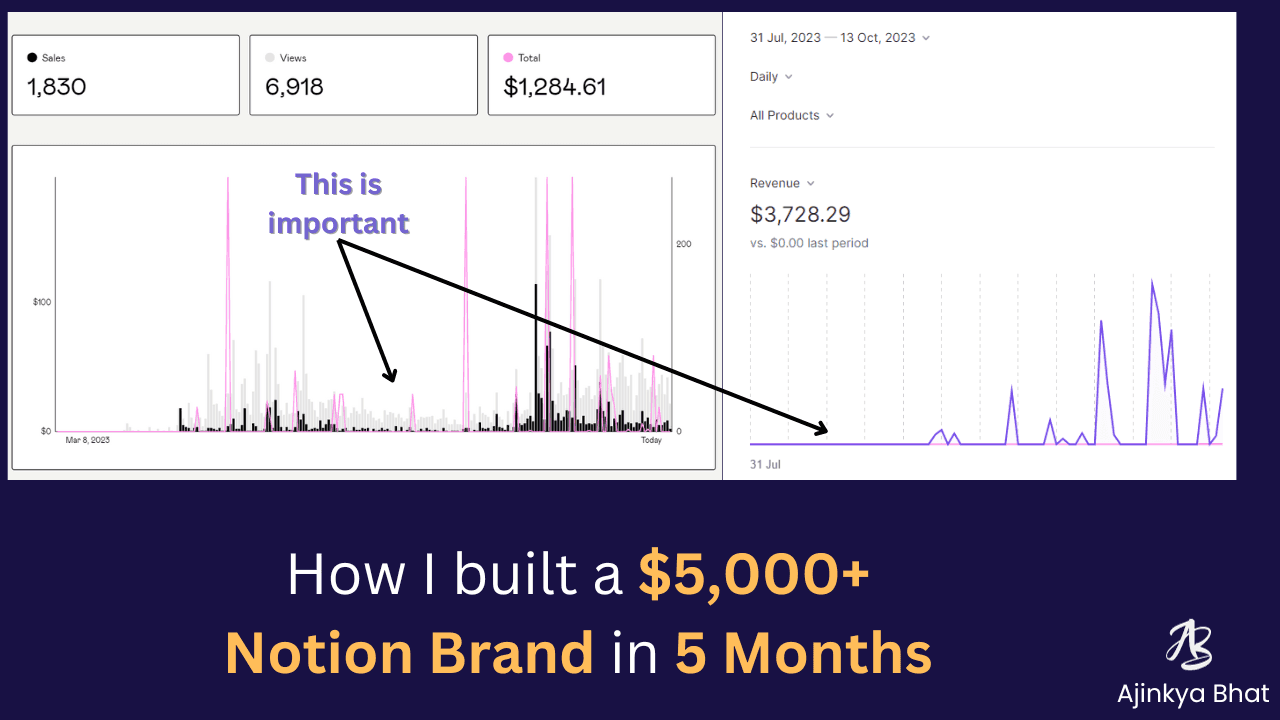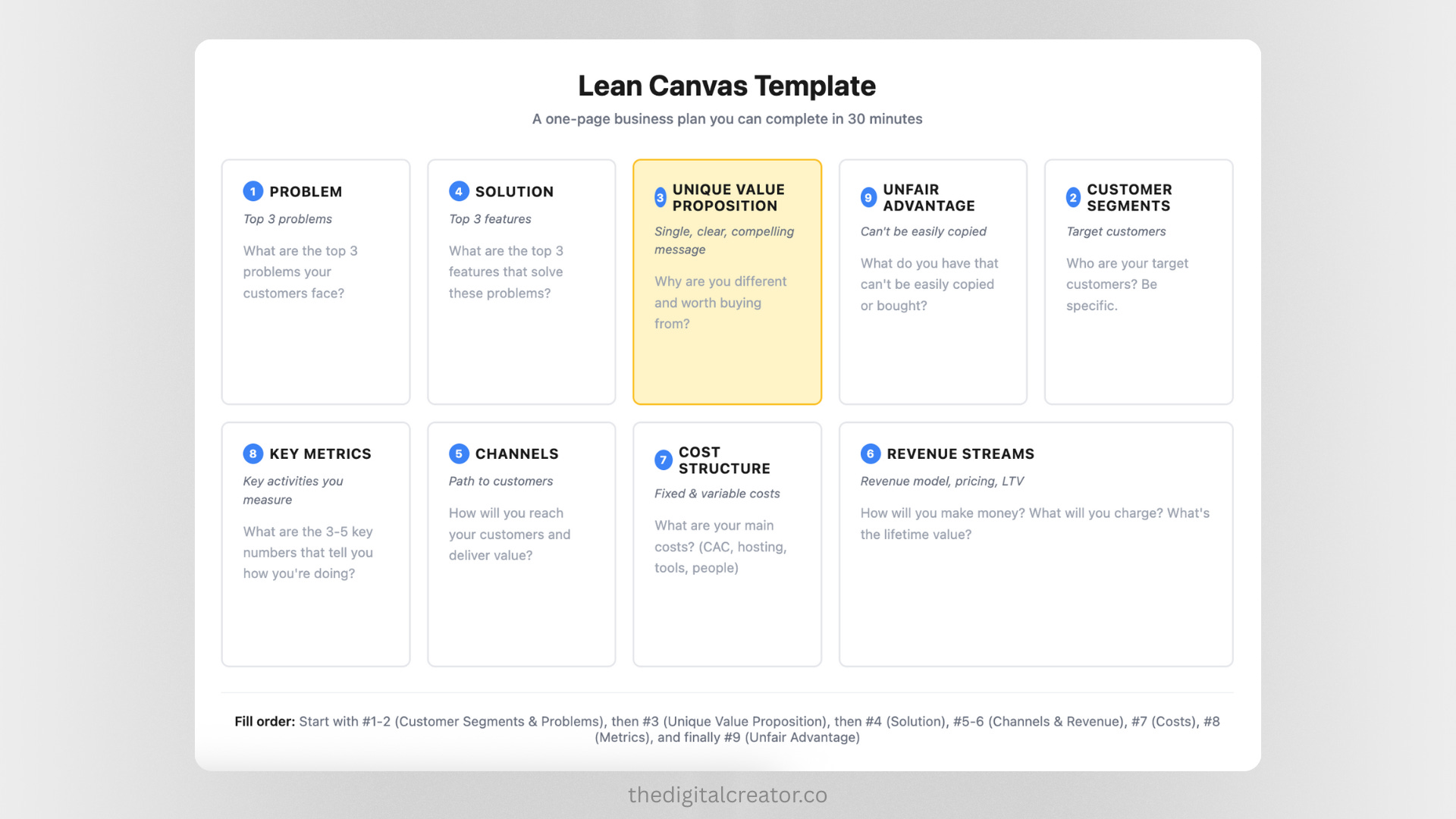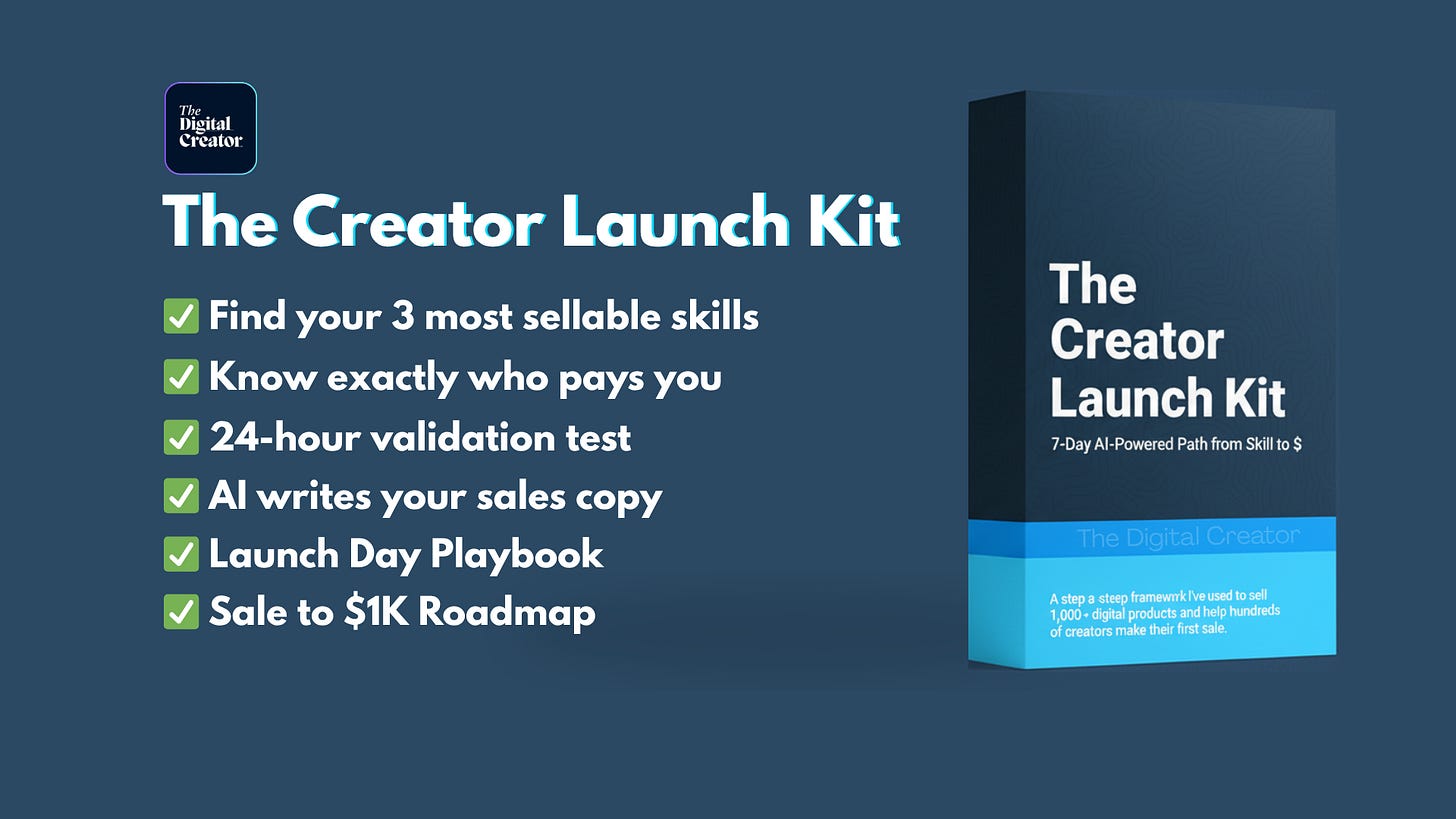Welcome to The Digital Creator, helping creators turn their skills into consistent income by building a clear offer, a content system that grows their audience, and a lean business using AI.
Digital product creators earned $16 billion in 2024. But here’s what nobody talks about: 95% of products fail.
Why?
Because most creators start with “I have a great idea!”
That’s backwards.
The ones actually making money? They start with “I found an expensive problem that people desperately need solved.”
The difference between these two approaches isn’t subtle. It’s the difference between launching to crickets and pre-selling 400 units before you write a single word.
Today, I’m breaking down the exact frameworks successful creators use to generate, validate, and refine digital product ideas. Plus the market data showing what’s actually selling in 2025. And how to choose the right format so you don’t waste months building the wrong thing.
If you’ve been sitting on a product idea—or you’re not sure what to build next—this is your blueprint.
Let’s get into it.
The Market Reality (What’s Actually Working)
Before we talk about your product idea, let’s look at what’s actually selling.
The creator economy hit $205 billion in 2024. It’s projected to reach $1.5 trillion by 2033.
Sounds incredible, right?
Here’s the truth nobody wants to tell you: 71% of creators earn under $30,000 a year. Only 9-18% cross the $100,000 threshold.
The difference between these two groups isn’t luck. It’s not audience size either.
It’s strategic product selection and proper validation.
What’s Selling (and for How Much)
Online Courses: The Proven Path to Six Figures
Price range: $97-$497
Here’s why courses dominate: 70% of six-figure creators identify courses as their number one revenue source. The e-learning market is massive…$257.7 billion by 2028…and shows no signs of slowing.
Teachable creators alone earned $400 million in 2020.
Kajabi creators? $6 billion in 2024.
The fastest-growing niches on Teachable:
Fashion and beauty
Academics and languages
Software and technology training
But here’s what matters more than the niche: the transformation you deliver.
Templates & Tools: The Speed-to-Market Winner
Price range: $15-$197
Creation time: 1-3 weeks
Thomas Frank made $1 million from just two Notion templates.
Not 20 products. Not 100. Two.
His “Creator’s Companion” ($49) and “Ultimate Brain” ($179) started generating $15,000 monthly in 2021. They still sell today, mostly on autopilot.
Another creator, Ajinkya Bhat, earned $10,000 in seven months selling his “StartOS” template at $197. He hit $5,000 in just 41 days.
Best-selling template categories:
Business and productivity planners
Budget and financial trackers
Social media content systems
Project management frameworks
Templates convert at 3-8% because they deliver immediate value. Someone buys your template at 2pm and uses it by 3pm. That’s powerful.
Memberships: The Recurring Revenue Play
Average price: $48/month
Retention rate: 60-80% (when community is engaged)
This is the model that turns $500/month into $5,000/month into $50,000/month.
Justin Rhodes crossed $100,000 monthly with his homesteading membership.
Rob Young generates $40,000+ monthly teaching music education through his Prodigies subscription.
The reason memberships work? Consumers want ongoing access, not one-time purchases. 76.6% of consumers wish their favorite brands had communities. 88.1% want two-way dialogue.
When you build community around your product, you’re not just selling information. You’re selling belonging, accountability, and transformation over time.
That’s sticky. That’s valuable.
The Key Insight Most Creators Miss
Six-figure creators on Kajabi average just 309 paying customers.
Read that again.
Not 10,000 followers. Not 50,000 email subscribers. Just 309 people who bought their product.
Their average stats:
1,000-10,000 social media followers
4,000 email subscribers
309 paying customers
This proves that small, engaged audiences dramatically outperform large, passive followings.
It’s not about the size of your audience.
It’s about selling the right product to the right people at the right price.
Now that you know what’s working, let’s talk about how to find YOUR idea…the one people will actually pay for.
The Problem-First Ideation Framework
Stop starting with “I want to create a course about X.”
Start here instead: “What problem are people struggling with that costs them time, money, or sanity?”
The most successful creators I’ve studied don’t begin with their idea. They begin with their customer’s problem.
Here’s the exact framework they use.
The Discovery Sandwich Method (3 Steps)
Step 1: Customer Interviews (Week 1)
Conduct 10-20 interviews using The Mom Test principle. This means you ask about problems, not solutions. You don’t pitch your idea. You don’t ask “Would you buy this?”
You ask questions like:
“What’s the biggest challenge you’re facing with [topic] right now?”
“What have you tried so far to solve this? Why didn’t it work?”
“When was the last time this problem cost you time or money?”
“Walk me through the last time this happened. What did you do?”
The goal? Find patterns. When 7 out of 10 people mention the same struggle, you’ve found something real.
Step 2: Stack Ranking (Week 1-2)
Now you take those problems and validate which ones actually matter most.
Use tools like OpinionX to create pair-ranking surveys. Users choose between two problems at a time: “Which is more frustrating: A or B?”
This reveals TRUE priorities, not just what people say matters.
Why does this work? Because when someone tells you “everything is important,” nothing is actually important. Stack ranking forces real decisions.
Here’s the critical threshold:
If your problem doesn’t rank in the top 3 out of 10+ problems, don’t build it.
One founder spent seven months validating an idea only to discover through stack ranking that it ranked 45th out of 45 problems. Seven months wasted because he skipped this step.
Step 3: Deep-Dive Validation (Week 2)
Interview only the people who ranked your problem in their top 3.
Ask:
“If I could solve this problem for you, what would that be worth?”
“What would change in your business/life if this was solved?”
“Would you pay $X to solve this right now?”
Watch their reaction. Hesitation means they don’t actually care enough. Enthusiasm means you’re onto something.
One creator I know pre-sold 400 units of a $10 course before creating a single lesson. He sent an email saying, “I’m building this. If you want early access at this price, buy now.”
400 people bought. That’s validation.
The 95% Failure Rule
Most product launches fail. That’s just the reality.
But products with proper validation are 3x more likely to succeed. Products that pre-sell before building? They hit 80-90% success rates.
The difference is this: you’re not guessing. You’re building what people have already told you they need and will pay for.
My 5-Step Product Validation Framework
Here’s how I do it:
Step 1: Survey Your Audience
Send one simple question: “What’s the biggest problem you’re currently having with [topic]?”
Collect 50-100 responses. Paste them into a word cloud or ChatGPT with the prompt: “Analyze these responses and identify the top 5 recurring problems.”
Then…and this is critical…use their exact language in your marketing.
If they say “I’m drowning in content ideas but can’t execute,” don’t translate that to “streamline your content workflow.” Use their words. “Stop drowning in content ideas.”
Step 2: Create a Lean Canvas (30 minutes)
A Lean Canvas is a one-page business plan. It maps:
Customer segments (who are you serving?)
Their top 3 problems
Your solution
Your unique value proposition
Revenue streams
Key metrics
Don’t overthink it. This is a living document. You’ll update it as you learn.
Step 3: Pre-Sell Before You Build
Create a simple landing page. Write the transformation you’re promising. Show the outcome.
Add a buy button with early-bird pricing.
Then drive traffic: email your list, post on social, share in communities.
Target: 20-50 pre-sales validates real demand. If you can’t get 20 people to pay before it exists, you won’t get 200 after it exists.
Step 4: Build Your MVP (2-3 weeks max)
MVP = Minimum Viable Product.
This is the simplest version that solves the core problem. Not perfect. Not comprehensive. Just functional.
Focus on solving ONE problem really well. Not ten problems, okay?
Launch at 70% done. You’ll learn more in one week with real users than in six months building alone.
Step 5: Launch & Learn
Track these metrics:
Conversion rate (how many visitors buy?)
Completion rate (how many finish your product?)
Customer feedback (what do they love? what’s missing?)
Iterate weekly based on data, not feelings.
And remember: most successful products take 6-12 months to gain real traction. If you’re at month 2 and discouraged, you’re right on schedule.
The Bottom Line
Problem-first thinking beats solution-first building every single time.
You’re not looking for a “great idea.” You’re looking for an expensive, frequent, or painful problem that people are desperate to solve.
Find that problem. Validate that people will pay to solve it. Then build the solution.
That’s how you avoid being part of the 95% that fail.
Using AI to Accelerate Ideation
84-91% of creators are using AI for productivity.
But here’s the problem: most are using it wrong.
They’re asking AI to write their entire product. To create their content from scratch. To replace their thinking.
That creates generic, forgettable products that sound like everyone else.
The creators making money with AI? They use it as a co-pilot, not a replacement.
Let me show you how.
The AI Ideation Workflow
Prompts To Refine Your Idea:
Here are three prompts I use constantly:
1. Gap Identification Prompt:
Generate 10 product opportunities in [your topic].
For each opportunity, articulate the complete market gap:
What specific problem exists, why current solutions fail to address it adequately, and what format would best deliver your solution (e.g., course, template, toolkit, guide).
Frame each as a compelling product concept that demonstrates both demand and differentiation.
Example: If your topic is “email marketing for coaches,” AI will analyze the market and suggest ideas like “Email sequences that convert cold leads” or “Templates for launching your first paid newsletter.”
2. Market Analysis Prompt:
Analyze the [your niche] market in 2025.
Tell me:
- What are the top 5 problems people are trying to solve?
- What solutions currently exist?
- Where are the gaps that aren’t being addressed well?
- What format would serve each gap best?
This gives you a landscape view. You’ll see opportunities others are missing.
3. Product Structure Prompt:
Create a detailed outline for a [course/guide/template] that helps [your audience] achieve [specific outcome].
Include:
- Module breakdown with learning objectives
- Key deliverables for each section
- Estimated time to complete each module
- Suggested price point based on transformation deliveredThis turns a vague idea into a concrete structure you can actually build.
The Right Way to Use AI
Here’s the framework:
AI handles:
Structure and organization
Research and data compilation
First drafts and outlines
Brainstorming and ideation at scale
YOU handle:
Your unique perspective and experience
Personal stories and examples
Final editing for authenticity
Strategic decisions about what to build
Think of it like this: AI is your research assistant and rough draft writer. You’re the creative director and editor-in-chief.
100% of successful creators add their human perspective to avoid generic-feeling content. They don’t copy-paste AI outputs. They use AI to think faster, then add their voice.
My Real-World AI Workflow
Here’s exactly how I use AI when developing a product idea:
Phase 1: Ideation (30 minutes)
Ask ChatGPT/Claude for 10 product ideas in my niche
Review and mark the 5 that solve real problems I’ve heard about
Run each through the Gap Identification prompt
Phase 2: Market Research (1 hour)
Use the Market Analysis prompt for each idea
Search Reddit, Twitter, and Facebook groups for people discussing these problems
Use ChatGPT/Claude to analyze patterns: “Here are 50 comments about [problem]. What are the recurring themes?”
Phase 3: Validation (Week 1)
Take the top 2 ideas
Create customer interview questions using ChatGPT/Claude
Conduct actual interviews (AI can’t do this part)
Feed interview notes back to ChatGPT/Claude: “Based on these 10 interviews, which problem is most urgent?”
Phase 4: Outline Creation (2 hours)
Use the Product Structure prompt
AI gives me the skeleton
I add my frameworks, examples, and stories
I reorganize based on how I actually teach
Phase 5: Content Creation (ongoing)
AI writes rough drafts of sections
I rewrite 60-80% to add my voice
I add personal examples AI could never know
I adjust based on my audience’s specific context
The Tools I Actually Use
For Ideation & Research:
ChatGPT (brainstorming, analysis, structure)
Perplexity (market research with sources)
Claude (longer context for analyzing customer interviews)
For Visuals:
Canva (template design, slide decks)
For Content:
Claude for outlines and first drafts
My brain for final editing and voice
What AI Can’t Replace
Your judgment about what’s worth building.
Your understanding of your specific audience’s context.
Your ability to tell stories that create connection.
Your taste in deciding what’s good enough to ship.
These are the things that separate average products from exceptional ones. AI gives you speed. You give it soul.
The Reality Check
Content production costs have dropped 70% with AI assistance. Course creation time is down 40-60%.
That’s incredible leverage.
But remember: faster production doesn’t mean better products. It means you can test more ideas, iterate quicker, and find product-market fit faster.
Use AI to accelerate learning, not to skip thinking.
Now that you know how to generate and validate ideas with AI’s help, let’s talk about choosing the right format for your product.
Choosing Your Product Format
You’ve validated the idea. People want it. They’ll pay for it.
Now comes the question that trips up most creators:
What format should I build?
Ebook? Course? Template? Membership?
The wrong choice here costs you months of time building something that doesn’t fit your strengths or your audience’s needs.
Here’s how to decide.
The Format Decision Framework
Consider these 4 factors:
1. Your Available Time for Creation
Be honest. How much time can you actually dedicate to building this?
If you’re working full-time and building on the side, a 40-hour video course isn’t realistic. A template you can build in 10-15 focused hours? That works.
2. Your Existing Skills
Are you a strong writer? Visual thinker? Comfortable on camera?
Play to your strengths. A video course requires comfort with being on camera, video editing, and creating visual presentations.
An ebook requires strong writing and the ability to explain concepts clearly in text.
Don’t force yourself into a format that requires skills you don’t have…or aren’t willing to develop.
3. Your Audience’s Learning Preferences
How does your audience actually consume content?
Survey them. Ask: “When learning something new, do you prefer reading a guide, watching videos, or using a done-for-you template?”
Their answer tells you everything.
4. The Transformation You’re Delivering
Some transformations require certain formats.
Teaching someone to edit video? You need video.
Teaching someone a productivity system? A template works better.
Teaching a complex framework? A course with multiple modules makes sense.
Match format to outcome.
Format Comparison
Ebooks and PDF Guides
Creation time: 2-6 weeks
Price range: $7-$49
Conversion rate: 2-5%
Best for:
Step-by-step processes
Reference materials you want people to search through
Text-heavy content (checklists, frameworks, scripts)
Start here if:
You’re a strong writer
You want to launch fast
You’re validating demand before building something bigger
Reality check:
Ebooks are quick to create but face high competition. The perceived value is lower than video. But as a first product or lead magnet? They work.
I’ve sold PDFs at $27 that took me three days to create. Fast validation, immediate revenue, low risk.
Video Courses
Creation time: 4-12 weeks
Price range: $97-$497
Conversion rate: 1.5-2.4%
Best for:
Complex topics that need demonstration
Technical or visual skills (design, software, cooking)
Audiences that prefer visual learning
Start here if:
You’re comfortable on camera
You’re solving problems that benefit from showing, not just telling
You want to command premium pricing
Reality check:
Video courses create stronger student connections than text. Completion rates are higher. You can charge more.
But production takes significantly more time. Recording, editing, creating slides, managing files…it adds up.
Templates and Toolkits
Creation time: 1-3 weeks
Price range: $15-$197
Conversion rate: 3-8%
Best for:
Process-driven work (project management, content planning)
Productivity systems (planners, trackers, workflows)
Design work (Canva templates, social media kits)
Start here if:
You have proven systems people ask you about
You want the fastest path to revenue
You want to create once and sell repeatedly with minimal updates
Reality check:
Templates convert at 3-8% because they deliver immediate value. Someone buys your content calendar template at noon and uses it by 1pm. That’s powerful.
Thomas Frank made $1 million from two Notion templates. Ajinkya Bhat made $10,000 in seven months from one template at $197.
The market is huge. Notion alone has 100 million users and 4 million paying subscribers. That’s massive demand for productivity systems.
Memberships and Communities
Setup time: 2-4 weeks + ongoing content
Price range: $20-$100/month
Retention rate: 60-80% (when engagement is high)
Best for:
Ongoing learning with regular updates
Building committed communities
Providing accountability and peer support
Start here if:
You love teaching and showing up consistently
You want recurring revenue
You can commit to creating content monthly (or weekly)
Reality check:
Memberships create predictable income. $48/month × 300 members = $14,400/month. And if you maintain 70% retention, that revenue is stable.
But memberships demand consistency. You can’t launch and disappear. You need fresh content, active community management, and regular engagement.
Creators crossing $100,000+ monthly with memberships typically have just 300-500 active paying members. Small, engaged communities beat large, passive ones every time.
My Recommendation for Most Creators
Start with a mid-ticket digital product ($197-$497 course OR $49-$197 template).
Why?
The math works:
50 sales at $200 = $10,000
50 sales at $20 = $1,000
Same number of sales. 10x the revenue.
The psychology works:
High enough price that it matters
Low enough barrier that people will buy without a sales call
Builds authority for higher-ticket offerings later
The effort works:
You’re not selling 500 units to make $5,000
You’re not managing ongoing community demands (yet)
You can focus on creating something excellent once
Start mid-ticket. Prove the model. Scale from there.
Pricing Strategy That Actually Works
Your pricing determines your revenue potential more than your product quality.
Read that again.
You can have the best course in the world, but if it’s priced at $19, you need massive volume to make meaningful money. And volume is exhausting.
Here’s the math that most creators get wrong.
The Pricing Tiers
Low-Ticket ($10-50)
This is the volume game.
To make $5,000/month at $10 per sale, you need 500 sales. That’s 17 sales every single day.
Conversion rates at this level run 1.5-5%. Let’s say you’re hitting 3%. You need 16,667 visitors per month to generate 500 sales.
Where are you getting 16,667 visitors?
Best for: Lead magnets, audience building, proving demand.
Mid-Ticket ($50-500) ⭐ THE SWEET SPOT
This is where most solo creators should start.
Here’s why the math changes everything:
At $99 with 1.5% conversion and 4,200 monthly visitors, you generate $6,237/month.
At $200, you need just 2,100 visitors for 50 sales.
Compare that to a $20 product: you’d need 21,000 visitors for those same 50 sales to generate $1,000.
Same effort. 10x different results.
Price range: $197-497 for courses, $49-197 for templates.
Conversion rates: 1.5-2% on average.
Why this works:
High enough price to matter financially
Low enough barrier that people buy without a sales call
Builds authority for premium offerings later
You’re not chasing volume
Group coaching at $997-$1,997 sits at the top of mid-ticket and converts well because personalized support justifies the premium.
High-Ticket ($500+)
Lower conversion rates (0.5-1%) but higher revenue per sale.
Rob Lennon earned $500,000 in his first year as a solopreneur selling AI education at high-ticket prices with 96% profit margins.
The requirements change here:
More trust needed upfront
Stronger authority and social proof
Often includes personalized support
May require discovery calls
Best for: Comprehensive flagship courses, one-on-one coaching, premium group programs.
The Value Formula
Price = Transformation, NOT Time Spent Creating
This is the mindset shift that changes everything.
A template that took you 2 hours to create but saves your customer 40 hours per month? That can command $197+ easily.
Why? Because the value is in the outcome, not the input.
Your customer doesn’t care that you built it in a weekend. They care that it solves a problem that’s been costing them time, money, or sanity.
Price for the transformation you deliver, not the hours you invested.
The Bottom Line
Start mid-ticket. Test your pricing. Scale based on results.
Most creators price too low because they’re afraid no one will buy. But underpricing attracts the wrong customers and makes sustainability impossible.
Charge what the transformation is worth. Not what you think people can afford.
The Trend We See…
The formats that are winning right now aren’t accidents. They’re responding to how people actually want to learn in 2025.
Here’s what’s gaining traction.
Micro-Courses: Shorter Is Winning
3-5 hour programs are destroying traditional 20+ hour courses.
Why? 80% completion rates versus 3-10% for traditional self-paced courses.
People don’t want encyclopedias anymore. They want focused solutions they can finish.
The data backs this up:
85% of organizations use video-based microlearning
Information retention improves 20% over traditional formats
Visual processing happens 60,000 times faster than text
Perfect for: Mobile consumption, busy professionals, solving one specific problem.
Price point: Around $25 or less for high accessibility.
One focused micro-course that solves a painful problem beats a comprehensive course that never gets finished.
Cohort-Based Courses: Community Drives Completion
85-90% completion rates through scheduled sessions and peer accountability.
That’s not a typo. When people learn together, they actually finish.
Corporate adoption proves it: 93% of organizations view cohort learning as essential by 2025, with companies seeing 90%+ completion rates versus single-digit self-paced rates.
Why it works:
Scheduled sessions create accountability
Peer-to-peer learning adds value
Real-time feedback lets you adapt
Network effects increase value with each member
Price range: $297-$2,997 (premium pricing justified by live involvement)
Platforms: Maven, Circle, Thinkific Classroom
The live element creates urgency. “Join this cohort or wait 3 months for the next one” converts better than “buy anytime.”
AI-Integrated Products: Production at Scale
2 million+ AI-generated course elements on Teachable in 2024 alone. That’s 250% growth since 2023.
Current adoption:
52% of small businesses use AI for content creation
63% of marketers use generative AI for written content
93% of AI users report faster content creation
What’s working:
ChatGPT for brainstorming, scripting, and first drafts
Midjourney/DALL-E for course visuals and social graphics (10+ variations in minutes)
Synthesia for explainer videos in 140+ languages
Canva AI for template creation
The results:
Content production costs down 70%
Course production time down 40-60%
The critical factor: 100% of successful creators add human perspective. AI handles structure and speed. Humans provide creativity, taste, and authenticity.
Use AI as a co-pilot, not a replacement. That’s how you create fast without creating generic.
So,...Here is my Take.
Shorter content. Live cohorts. AI-assisted production. Hybrid models combining multiple formats.
These aren’t fads. They’re responses to real market demands: people want results faster, community matters more than ever, and production needs to be efficient.
Build with these trends in mind, not against them.
Your Next Steps
You’ve got the frameworks. You’ve got the data. You know what’s working.
Now it’s time to build.
Here’s your action plan for the next 30 days:
Week 1: Validate Your Idea
Conduct 10 customer interviews
Complete your Lean Canvas (30 minutes)
Identify your top problem to solve
Use stack ranking if you have multiple ideas
Don’t skip validation. This week saves you months of building the wrong thing.
Here is a more personal approach, (how I do it)
Week 2: Choose Your Format
Survey your audience about learning preferences
Match format to your skills and available time
Outline your MVP (minimum viable product)
Set your pricing based on transformation, not creation time
Remember: mid-ticket ($197-497 for courses, $49-197 for templates) is the sweet spot.
Week 3: Build Your MVP
Create the core solution only
Focus on solving ONE problem extremely well
Don’t aim for perfect—aim for “good enough to test”
Launch at 70% done
Done beats perfect. Every single time.
Here is how I do it 👇
Week 4: Pre-Sell & Launch
Create your sales page
Email your list
Share in communities where your audience hangs out
Target 20-50 early customers for validation
If you can’t get 20 people to buy before it’s finished, you won’t get 200 after.
Remember These Numbers
Average time to first dollar: 6.5 months
Six-figure creators have: 5-7 revenue streams
Six-figure creators on Kajabi average: Just 309 customers
Email converts better than any social platform
Timeline to $100K: 40% reach it in under 2 years with consistent effort
The Reality Check
This isn’t a get-rich-quick plan. It’s a build-something-real plan.
59% of full-time creators experience burnout. That’s because they’re trying to do everything at once.
Don’t do that.
Start with one product. Validate it properly. Launch it. Get feedback. Iterate.
Then build the next one.
The opportunity is massive. Creators earned $10 billion on platforms like Kajabi and Teachable in 2024 alone.
But it requires strategic thinking, not hopeful building.
Start with one mid-ticket product.
Build your email list.
Validate demand before full production.
Then diversify and scale over 12-24 months.
The creator economy is growing from $205 billion today to $1.3-1.5 trillion by 2033.
There’s room for you.
But only if you start with strategy, not just enthusiasm.
Build what people need. Price it for the transformation. Launch it before it’s perfect.
That’s how you go from idea to income.
Want Help Turning Your Idea Into a Product?
You have 2 ways to work with me:
Option 1: Start Free
Get the Creator Launch Kit
This is for:
✅ You have skills but no product
✅ You’re tired of guessing what will sell
✅ You want to launch fast (days, not months)
✅ You want AI to do the heavy lifting
✅ You’re ready to make your first $1,000
Price: Free
Perfect if: You want to test AI-assisted product development before investing.
Option 2: Work With Me 1:1
The Digital Creator Blueprint
We’ll clarify your offer, validate your idea, and create your complete launch plan in one intensive session.
What’s included:
90-minute strategy call to nail your product concept
Offer crafting and positioning
Audience validation framework
30-60 day content and launch plan
Lean Canvas and pricing strategy
2 follow-up calls for accountability
Delivery: Zoom + Notion workspace with everything documented
Perfect if: You want expert guidance to avoid the mistakes that kill 95% of products.
One More Thing
If you found this valuable, forward it to another creator who’s trying to figure out what to build.
The best products come from strategic thinking, not random inspiration.
Until next time - Sharyph | Founder of The Digital Creator.
Want to Sponsor the Newsletter?
Put Your Product/Service in Front of 18,000+ Creators.



